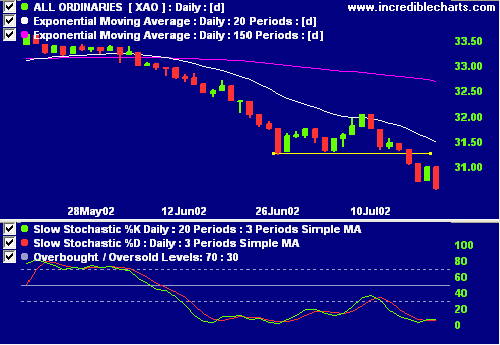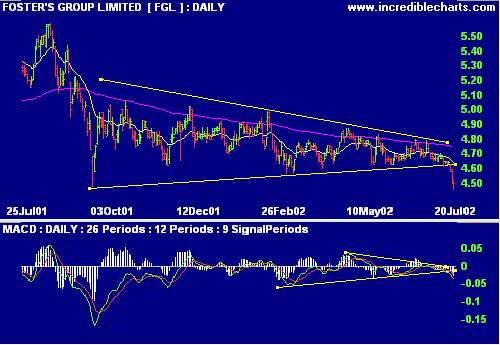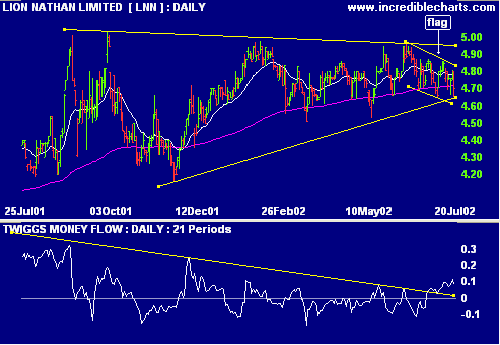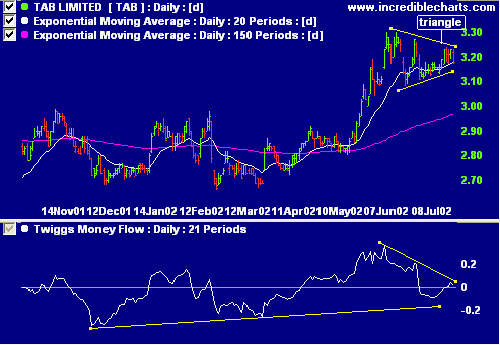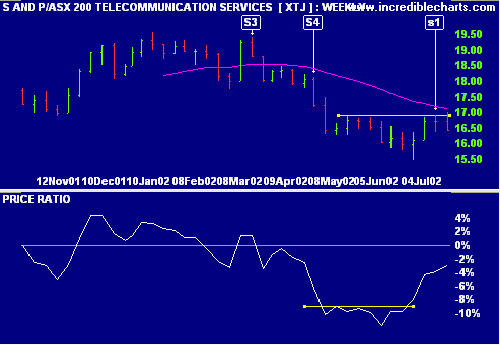Trading Diary
July 19, 2002
These extracts from my daily
trading diary are intended to illustrate the techniques used in
short-term trading and should not be interpreted as investment
advice. Full terms and conditions can be found at Terms
of Use .
USA
The Dow crashed more than 4.5% to close at 8019
on strong volume, just above the key 8000 support level. We are
now entering the third stage of the
bear market. Primary and secondary cycles trend
downwards.
The Nasdaq Composite lost 2.8% to close at
1319, below the 1357 October 1998 support level.
The primary and secondary cycles are in a down-trend.
The S&P 500 dropped 34 points to close at
847. The next support level is 804, from April 1997.
Primary and secondary cycles trend downwards.
Johnson & Johnson
J&J stock fell 16% on allegations of false
record-keeping at a plant that makes the Eprex anemia drug,
linked to serious side-effects. (more)
AOL Time Warner
AOL falls 7% after a management shakeout and resignation of COO
Bob Pittman.
(more)
Sun Micro
Sun Microsystems stock dropped 27% after
the company lowered 2003 revenue and earnings forecasts.
(more)
ASX Australia
Another drop of more than 1%, with the All Ordinaries closing
down 42 points at 3058 on above-average volume.
The primary cycle and secondary cycle
are in a bear trend.
Slow Stochastic (20,3,3) is above its signal line while MACD
(26,12,9) is below.
Exponentially-smoothed money flow signals distribution.
Brewers group
Fosters
[FGL] and Lion Nathan [LNN] have
enjoyed a year of "friendly" competition.
(more)
FGL has experienced a downward breakout from a symmetrical
triangle formed over the past 9 months. Relative Strength (price
ratio: xao) is improving, while MACD and exponentially-smoothed
money flow are negative.
LNN has formed a similar triangle but has not
yet made a breakout. Relative Strength (price ratio: xao) is
strong, MACD is neutral, while exponentially-smoothed money
flow signals accumulation during the recent flag
pattern.
TAB [TAB]
TAB Limited has formed a congestion pattern that could be
described as a large pennant or small triangle.
Relative Strength (price ratio: xao) is positive but MACD has
turned back down. Exponentially-smoothed money flow signals
distribution over the period of the triangle pattern.
Sector Analysis
Stage changes are highlighted in
bold.
-
Energy [XEJ] - stage 1
-
Materials [XMJ] - stage 4 (RS is
rising)
-
Industrials [XNJ] - stage 4
-
Consumer Discretionary [XDJ] - stage
4
-
Consumer Staples [XSJ] - stage 4
-
Health Care [XHJ] - stage 4
-
Property Trusts [XPJ] - stage
3
-
Financial excl. Property Trusts [XXJ] -
stage 4
-
Information Technology [XIJ] - stage
4
-
Telecom Services [XTJ] - stage 1 (RS is
rising)
-
Utilities [XUJ] - stage 1 (RS is
rising)
The ASX has ceased to provide the old ASX indices.
Sectors: Relative Strength
A stock screen of
equities using % Price Move (3 months: +10%) is dominated by:
-
Base Metals
-
Computer & Office
-
Diversified Media
-
Gold Explorers
-
Gold Producers
-
Mining Explorers
-
Miscellaneous Industrials
-
Miscellaneous Services
-
Oil & Gas Explorers
-
Oil & Gas Producers
Conclusion
Short-term: Avoid new entries. The Slow Stochastic is above, and
MACD below, its signal line.
Medium-term: Wait for the All Ords to signal a reversal.
Long-term: Wait for a bull-trend on the Nasdaq or S&P 500
(primary cycle).
Colin Twiggs
Thought for the Day:
There are a few really outstanding
companies, whose stock normally sells at a substantial premium,
except in the final throes of a bear market.
Back Issues
Back
Issues
Access the Trading Diary Archives.
